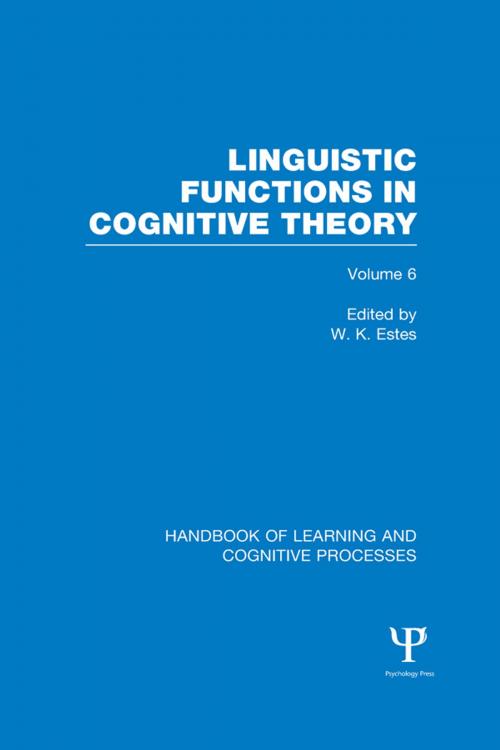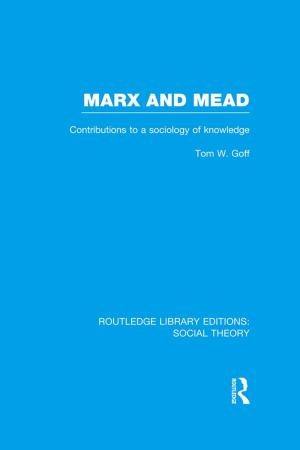Handbook of Learning and Cognitive Processes (Volume 6)
Linguistic Functions in Cognitive Theory
Nonfiction, Health & Well Being, Psychology, Cognitive Psychology| Author: | ISBN: | 9781317671985 | |
| Publisher: | Taylor and Francis | Publication: | June 20, 2014 |
| Imprint: | Psychology Press | Language: | English |
| Author: | |
| ISBN: | 9781317671985 |
| Publisher: | Taylor and Francis |
| Publication: | June 20, 2014 |
| Imprint: | Psychology Press |
| Language: | English |
Originally published in 1978, Volume 6 concludes the survey of research and theory on learning and cognitive processes that was envisaged when the plan for this Handbook was sketched.
The primary orientation in the planning the Handbook was to concentrate on research and models aimed toward the development of general cognitive theory.
The first five chapters of this volume are organized in relation to one of the research areas that had expanded most vigorously during the period of planning and writing of the Handbook. These chapters treat aspects of psycholinguistics most closely related to research and theory covered in the other volumes. Perhaps the most fertile source of new concepts and models closely related to other branches of cognitive theory has been research on semantic memory. This work is given a critical review and interpretation by Smith in the first chapter of this volume, following which some lines of theoretical developmental leading "upward" into problems of comprehension of meaningful material are reviewed by Kintsch, then connections "downward" into more elementary problems of coding in memory by Johnson. Also, Johnson’s chapter shades into the very active current body of work on perceptual and memorial processes in reading, carried further by Baron’s examination of perceptual learning in relation to letter and word recognition. Finally, we consider inputs to the psycholinguistic system via speech and speech perception. The strong emphasis of Pisoni’s chapter on speech perception rather than production simply reflects both the predominance of research on perceptual aspects of speech in the current cognitive literature and the close relationships of this research to other lines of investigation of perception and short-term memory.
Some knowledge of the history of the subject and some understanding of the way some of the more persuasive concepts and principles have evolved may serve present-day investigators better than boosting their reading rates. The final chapter of the present volume provides some documentation for this last suggestion.
Originally published in 1978, Volume 6 concludes the survey of research and theory on learning and cognitive processes that was envisaged when the plan for this Handbook was sketched.
The primary orientation in the planning the Handbook was to concentrate on research and models aimed toward the development of general cognitive theory.
The first five chapters of this volume are organized in relation to one of the research areas that had expanded most vigorously during the period of planning and writing of the Handbook. These chapters treat aspects of psycholinguistics most closely related to research and theory covered in the other volumes. Perhaps the most fertile source of new concepts and models closely related to other branches of cognitive theory has been research on semantic memory. This work is given a critical review and interpretation by Smith in the first chapter of this volume, following which some lines of theoretical developmental leading "upward" into problems of comprehension of meaningful material are reviewed by Kintsch, then connections "downward" into more elementary problems of coding in memory by Johnson. Also, Johnson’s chapter shades into the very active current body of work on perceptual and memorial processes in reading, carried further by Baron’s examination of perceptual learning in relation to letter and word recognition. Finally, we consider inputs to the psycholinguistic system via speech and speech perception. The strong emphasis of Pisoni’s chapter on speech perception rather than production simply reflects both the predominance of research on perceptual aspects of speech in the current cognitive literature and the close relationships of this research to other lines of investigation of perception and short-term memory.
Some knowledge of the history of the subject and some understanding of the way some of the more persuasive concepts and principles have evolved may serve present-day investigators better than boosting their reading rates. The final chapter of the present volume provides some documentation for this last suggestion.















